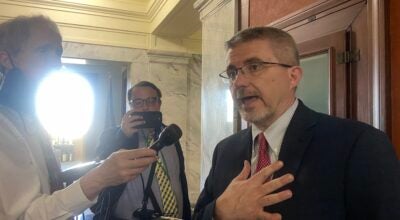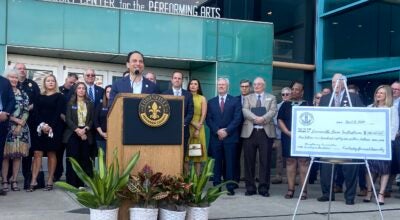What did Eastern Kentucky win (and lose) in the budget?
Published 1:13 pm Wednesday, May 8, 2024

- Senate President Robert Stivers and Sen. Brandon Storm pose with recipients of the road plan budget in Eastern Kentucky on Tuesday, May 7, at the London Creekside Gardens.
LONDON — Between historic flooding, an opioid crisis and a need for economic revitalization as coal mines close, Eastern Kentucky has a lot on its plate.
On a sunny Tuesday, surrounded by the colorful plants of London Creekside Gardens, Senate President Robert Stivers, R-Manchester, and Sen. Brandon Storm, R-London, explained how the state legislature stepped up to help in this year’s budget.
Transportation, broadband and jobs
The pair focused mostly on the legislature’s transportation investments, like three-laning I-75 to the Kentucky-Tennessee border and providing $6 million in seed money to four-lane the Hal Rogers Parkway from London to Hazard.
Good roads are key to provide access to Eastern Kentucky’s parks and other offerings, Stivers said.
But they aren’t only important for tourism.
“Transportation is such a key to creating a dynamic for jobs,” Stiver said. “…Access to jobs, if you don’t have those, people move out of the area, and that’s what’s happened to us in the last six, eight years.”
Developing broadband is probably item number two for bringing jobs to Eastern Kentucky, Stivers added.
The biennial budget includes nearly $20 million in state funds for pole replacements, as well as appropriates $1.08 billion in federal funds as part of the Broadband Equity Access and Deployment Program grant.
At least a dozen Eastern Kentucky counties are receiving funds for various water and sewer projects and upgrades, particularly surrounding Red River Gorge.
Tourism and economic diversification
Many of Eastern Kentucky’s budget wins are related to tourism, which is one way the region is trying to diversify as coal becomes a lesser portion of its economy.
The Kentucky Mountain Regional Recreation Authority got $3 million to maintain and promote its 18-county recreational trail system throughout Eastern Kentucky.
Save Our Appalachian Region (SOAR) got $1.5 million for remote talent attraction. Several counties are receiving funds for park projects, recreation centers and community centers. Laurel County is getting $1 million to revitalize its regional fairgrounds, which are sometimes the site of national archery competitions.
Over the next two years, $1.87 million will go to the Fleming-Neon Rising initiative, an economic development and rural development initiative led by Letcher County elected officials and citizens.
A $3.5 million land acquisition in Laurel County will be used to create a KFC-inspired convention center where people can learn the history of Colonel Sanders.
Storm said it’s all about “synergy in the mountains.”
“I just want to try to bring as much industry here and tourism and money for our folks,” he said.
Natural disaster recovery and affordable housing
While Eastern Kentucky earned several wins during this year’s budget talks, there was at least one area where advocates say it fell short—natural disaster recovery housing.
Scott McReynolds, Housing Development Alliance executive director, said while the Rural Housing Trust Fund was given $10 million across the biennium, advocates had asked for at least triple that amount.
A March 2024 Ohio River Valley Institute report found that rebuilding costs after the floods may be higher than anticipated.
According to the institute’s analysis, the federal government has provided $725 million in housing funds, private donors have contributed $50 million and the state has offered $22 million.
However, the overall cost of rebuilding 4,700 homes in safer locations and repairing damaged homes is estimated to reach $1.398 billion, leaving a gap of $525 million in need.
Senate President Stivers said it wouldn’t be prudent to give Eastern Kentucky all that money at once, although he expects the legislature to continue funding rural housing in future budgets
“Understand if I give you the money to build the house today, it’s gonna take you a while to build the house, so we tier it in,” he said. “…So you have to do what we can actually have the capacity to do.”
McReynolds said while matching capacity is important, it’s difficult to start building without solid guarantees that funding won’t stop in the future, or that an ongoing housing project will remain eligible for funding.
He added that the Rural Housing Trust Fund money isn’t limited to areas impacted by natural disaster, and most of rural Kentucky is experiencing an affordable housing crisis.
While advocates hope a significant portion will be earmarked for flood-impacted areas, they can’t be sure. Finally, McReynolds said higher ground communities being built in Eastern Kentucky are expensive, so money might not be stretching as far as people think.
Opioid crisis
Both Stivers and Storm have witnessed the effects of the opioid crisis during their time as attorneys.
Stivers said there’s two groups they need to focus on—the people who’ve gotten into bad breaks who need rehabilitation from substance use disorder, and the “profiteers,” who “need to be hammered quick, soon and hard.”
Several budget items address the crisis. Letcher County is getting funds for its Transitioning from Recovery to Society Program and $12 million for Pikeville Medical Center facility upgrades includes an expanded psychiatric and mental health ward.





